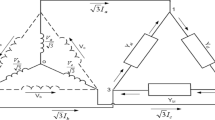Abstract
Self-excited induction generators (SEIG) are playing a vital role as useful machines to feed a three-phase load at remote and windy locations where possibility of grid extension is very poor. In isolated mode, the operation of self-excited induction generators under unbalanced load and excitation may results into over voltage and over current in any phase of the machine. In this paper, performance over five different rating machines have been investigated which may be helpful for the selection of best induction machine as SEIG in order to obtain maximum allowable operating range with in the acceptable limits of voltage and current during unbalanced operations. The model as presented has been formulated with a new objective function and its variables containing degree of unbalance, per unit frequency, magnetizing reactance of positive and negative sequence circuits has been solved using particle swarm optimization.
















Similar content being viewed by others
References
Al-Bahrani AH (1996) Analysis of self-excited induction generators under unbalanced conditions. Electr Mach Power Syst 24:117–129
Bhattacharya JL, Woodward JL (1988) Excitation balancing of a self-excited induction generator for minimum power output. IEE Proc 135(Pt. C, 2):88–97
Bonnet AH, Soukup GC (1993) Understanding the NEMA motor-generator standards of section MG-1-1993, revision, three-phase induction motors. Copyright Material IEEE, Paper No. PCIC-97-24, pp 225–238
Chan TF (1995) Analysis of self-excited induction generators using an iterative method. IEEE Trans Energy Convers 10(3):502–507
Eberhart RC, Shi Y (2002) Tracking and optimizing dynamic systems with particle swarms. In: Proceedings of the 2001 Congress on evolutionary computation, vol 1. IEEE, pp 94–100
Faiz J, Ebrahimpour H, Pillay P (2004) Influence of unbalanced voltage on the steady-state performance of a three-phase squirrel-cage induction motor. IEEE Trans Energy Convers 19(4):657–662
Joshi D, Sandhu KS, Soni MK (2006a) Constant voltage constant frequency operation for a self-excited induction generator. IEEE Trans Energy Convers 21(1):228–234
Joshi D, Sandhu KS, Soni MK (2006b) Performance analysis of three-phase self-excited induction generator using genetic algorithm. Electr Power Compon Syst 34(4):461–470
Kennedy J, Eberhart RC et al (1995) Particle swarm optimization. In: Proceedings of IEEE international conference on neural networks, vol 4. Perth, pp 1942–1948
Kheldoun A, Refoufi L, Khodja DE (2011) Analysis of self-excited induction generator steady state performance using a new efficient algorithm. Electr Power Syst Res 86:61–67
Kumar S, Yadav DK, Khan DA (2016) An adaptive PSO algorithm-based test data generator for data flow dependencies using dominance concepts. Int J Softw Eng Its Appl 10(11):59–82
Malik NH, Haque SE (1986) Steady state analysis and performance of an isolated self-excited induction generator. IEEE Trans Energy Convers EC-1(3):134–140
Murthy SS, Malik OP, Tandon AK (1982) Analysis of self-excited induction generators. IEE Proc 129(Pt. C, 6):260–265
Murthy SS, Singh B, Gupta S, Gulati BM (2003) General steady-state analysis of three-phase self-excited induction generator feeding three-phase unbalanced load/single-phase load for stand-alone applications. IEE Proc 150(1):49–55
Quazene L, McPherson G (1983) Analysis of the isolated induction generator. IEEE Trans Power Appar Syst PAS-102(8):2793–2798
Saha SK, Sandhu KS (2017) Optimization techniques for the analysis of self-excited induction generator. In: Procedia of 6th international conference on smart computing and communications (ICSCC), pp 405–411
Sandhu KS, Jain SK (1999) Operational aspects of self-excited induction generator using a new model. Electr Power Compon Syst 27(2):169–180
Shi Y, Eberhart RC (1998) Parameter selection in particle swarm optimization. Lect Notes Comput Sci Evol Program VII 1447:591–600
Singh SP, Singh B, Jain MP (1993) Comparative study on the performance of a commercially designed induction generator with induction motors operating as self-excited induction generators. IEE Proc 140(Pt. C, 5):374–380
Wang YJ, Huang YS (2009) Analysis of a stand-alone three-phase self-excited induction generator with unbalanced loads using a two-port network model. IET Electr Power Appl 3(5):445–452
Author information
Authors and Affiliations
Corresponding author
Additional information
Publisher's Note
Springer Nature remains neutral with regard to jurisdictional claims in published maps and institutional affiliations.
Rights and permissions
About this article
Cite this article
Chaturvedi, Y., Kumar, S. Selection of stand-alone self-excited induction generator parameters to obtain maximum allowable operating range under unbalanced operations using particle swarm optimization. Int J Syst Assur Eng Manag 11, 677–689 (2020). https://doi.org/10.1007/s13198-020-00983-y
Received:
Revised:
Published:
Issue Date:
DOI: https://doi.org/10.1007/s13198-020-00983-y




